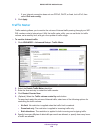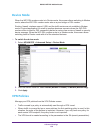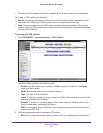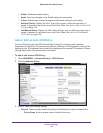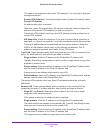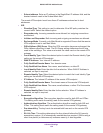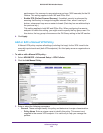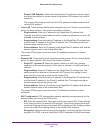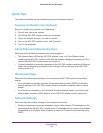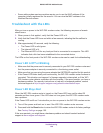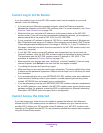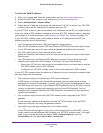
Advanced Settings
136
D6200 WiFi DSL Modem Router
- Remote VPN Endpoint. Select the desired option (IP address or domain name)
and enter the address or domain name of the remote VPN endpoint you wish to
connect to.
The remote VPN endpoint must have this VPN gateway’s address entered as its
remote VPN endpoint.
• Local LAN. These settings identify which computers on your LAN are covered by this
policy. For each selection, data must be provided as follows:
- Single address. Enter an IP address in the Single/Start IP address field.
Typically, this setting is used when you wish to make a single server on your LAN
available to remote users.
- Range address. Enter the starting IP address in the Single/Start IP address field,
and the finish IP address in the Finish IP address field. This setting must be an
address range used on your LAN.
- Subnet address. Enter an IP address in the Single/Start IP address field, and the
desired network mask in the Subnet Mask field.
The remote VPN endpoint must have these IP addresses entered as its remote
addresses.
• Remote LAN. These identify which computers on the remote LAN are covered by this
policy. For each selection, data must be provided as follows:
- Single PC - dynamic IP. Select this option if there is no LAN (only a single
computer) at the remote endpoint. If this option is selected, no additional data is
required.
- Single address. Enter an IP address in the Single/Start IP address field. This
setting must be an address on the remote LAN. Typically, this setting is used
when you wish to access a server on the remote LAN.
- Range address. Enter the starting IP address in the Single/Start IP address field,
and the finish IP address in the Finish IP address field. This range must be an
address range used on the remote LAN.
- Subnet address. Enter an IP address in the Single/Start IP address field, and the
desired network mask in the Subnet Mask field.
The remote VPN endpoint must have these IP addresses entered as its local
addresses.
• ESP Configuration. ESP (encapsulating security payload) provides security for the
payload (data) sent through the VPN tunnel.
- SPI. Enter the required SPIs. Each policy must have unique SPIs. These settings
must match those for the remote VPN endpoint. The Incoming setting here must
match the Outgoing setting on the remote VPN endpoint, and the Outgoing setting
here must match the Incoming setting on the remote VPN endpoint.
- Encryption. Select the desired encryption algorithm, and enter the key in the field
provided. For 3DES, the keys should be 24 ASCII characters (48 hex characters).



